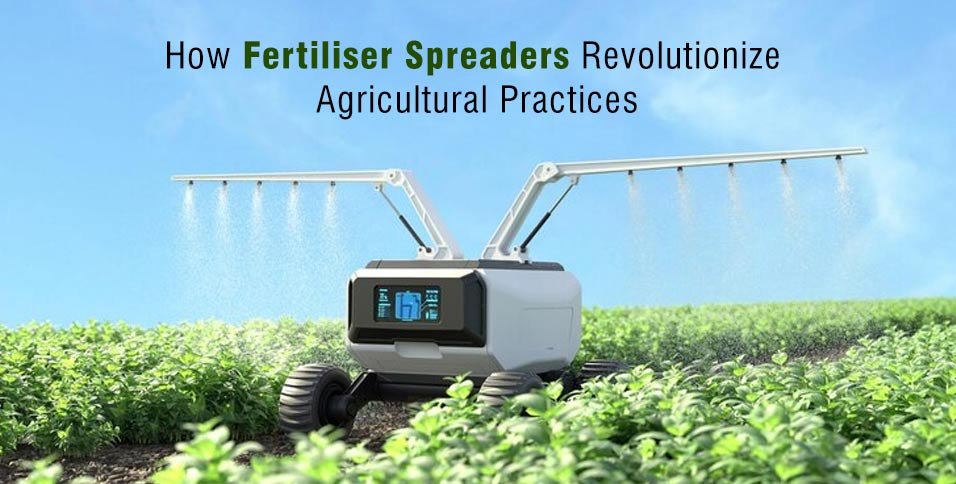By spreading nutrients evenly across areas, fertiliser spreaders improve both crop yield and soil health. They cut down on waste and the risk of over-fertilization. This blog will talk about the different kinds of spreaders, their features and benefits, and how they affect sustainable farming methods, such as protecting the environment and managing resources well.
Types of Fertiliser Spreaders
This fertiliser spreader is essential in agriculture and landscaping for distributing materials efficiently. This guide covers Broadcast Spreaders, Drop Spreaders, and Spinner Spreaders.
Broadcast Spreaders
By using spinning disks that make circular designs, broadcast spreaders are made to spread fertiliser evenly over large areas. Most of the time, they are used in farming and gardening to spread granular fertilisers, lime, and seeds.
The best things about broadcast spreaders are that they cover a lot of ground, so they can be used in large areas, and they save time during the application process.
Drop Spreaders
Drop spreaders work by carefully releasing fertiliser from under the machine. This makes them perfect for smaller areas or cases where precise fertilization is needed. In places where accuracy is important, like fields, gardens, and golf courses, they are often used.
One of the best things about drop spreaders is that they can apply fertiliser precisely and with little waste. This makes them useful tools for targeted jobs.
Spinner Spreaders
Spinner spreaders use spinning plates to spread fertiliser evenly. They can handle a variety of materials and can be adjusted to cover a wider area. They can be used for many things, like planting crops, orchards, and vineyards, where exact and even distribution is important.
Spinning spreaders are useful because they can cover a lot of ground, even if the ground isn’t level. This makes them great for making sure that all types of fields get the same amount of fertiliser.
Key Features and Benefits
Fertiliser spreaders provide benefits for efficient and sustainable farming, such as adjustable spread rates, uniform coverage, time savings with mechanized distribution, and reduced environmental impact.
1. Adjustable Spread Rate
Farmers change the spread rates to get the best results with the least amount of waste when applying powdered or liquid fertiliser. This optimization cuts down on extra nutrients that could throw off the balance of nature, making it more cost-effective and better for the earth.
Fine-tuning spread rates based on the type of soil, the needs of the crop, and the weather results in better nutrient management, healthier crops, higher outputs, and less damage to the environment.
2. Uniform Coverage
Even coverage is important for crop growth because it makes sure that fertiliser is spread out evenly across the area, giving plants the nutrients they need to grow.
Modern spreaders can do this with the help of high-tech features like flexible spread patterns, precise calibration, and GPS-guided systems. These features keep nutrient variations to a minimum and boost fertilization efficiency, leading to higher crop health and yields.
3. Efficiency and Time Savings
Spreaders automate the distribution of fertiliser, which saves time and effort and makes it possible to cover bigger areas more quickly. Spreading by hand takes a lot of time, especially in big fields.
Mechanized spreaders are more accurate and efficient because they have variable speeds, GPS guidance, and precise calibration. This makes sure that the coverage is even, which increases crop yields and farm production.
4. Reduced Environmental Impact
When fertiliser is applied precisely, it has less of an effect on the environment because it doesn’t run off or leach, which improves water quality and community health. This way of distributing fertiliser makes the best use of it, reduces waste, and lowers environmental risks.
Farmers who use precise methods can control the amount of nutrients they use, leave less of an impact on the environment, and protect ecosystems and natural resources.
Optimizing Agriculture with Fertiliser Spreaders
Fertiliser spreaders optimize crop yield and soil health by efficiently distributing nutrients, reducing wastage, and promoting sustainable farming. Exploring these benefits improves crop management, increases productivity, and supports environmental conservation. Adopting fertiliser spreaders enhances farming practices, yields, and sustainability in agriculture.
Also Read: How to Apply GIS Data to Agricultural Business and Farmers’ Daily Activities















